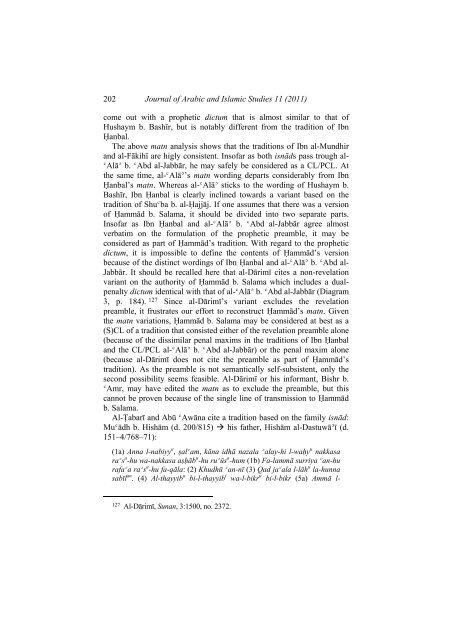JOURNAL OF ARABIC AND ISLAMIC STUDIES
JOURNAL OF ARABIC AND ISLAMIC STUDIES
JOURNAL OF ARABIC AND ISLAMIC STUDIES
You also want an ePaper? Increase the reach of your titles
YUMPU automatically turns print PDFs into web optimized ePapers that Google loves.
202<br />
Journal of Arabic and Islamic Studies 11 (2011)<br />
come out with a prophetic dictum that is almost similar to that of<br />
Hushaym b. Bashīr, but is notably different from the tradition of Ibn<br />
Ḥanbal.<br />
The above matn analysis shows that the traditions of Ibn al-Mundhir<br />
and al-Fākihī are higly consistent. Insofar as both isnāds pass trough al-<br />
ʿAlāʾ b. ʿAbd al-Jabbār, he may safely be considered as a CL/PCL. At<br />
the same time, al-ʿAlāʾ’s matn wording departs considerably from Ibn<br />
Ḥanbal’s matn. Whereas al-ʿAlāʾ sticks to the wording of Hushaym b.<br />
Bashīr, Ibn Ḥanbal is clearly inclined towards a variant based on the<br />
tradition of Shuʿba b. al-Ḥajjāj. If one assumes that there was a version<br />
of Ḥammād b. Salama, it should be divided into two separate parts.<br />
Insofar as Ibn Ḥanbal and al-ʿAlāʾ b. ʿAbd al-Jabbār agree almost<br />
verbatim on the formulation of the prophetic preamble, it may be<br />
considered as part of Ḥammād’s tradition. With regard to the prophetic<br />
dictum, it is impossible to define the contents of Ḥammād’s version<br />
because of the distinct wordings of Ibn Ḥanbal and al-ʿAlāʾ b. ʿAbd al-<br />
Jabbār. It should be recalled here that al-Dārimī cites a non-revelation<br />
variant on the authority of Ḥammād b. Salama which includes a dualpenalty<br />
dictum identical with that of al-ʿAlāʾ b. ʿAbd al-Jabbār (Diagram<br />
3, p. 184). 127 Since al-Dārimī’s variant excludes the revelation<br />
preamble, it frustrates our effort to reconstruct Ḥammād’s matn. Given<br />
the matn variations, Ḥammād b. Salama may be considered at best as a<br />
(S)CL of a tradition that consisted either of the revelation preamble alone<br />
(because of the dissimilar penal maxims in the traditions of Ibn Ḥanbal<br />
and the CL/PCL al-ʿAlāʾ b. ʿAbd al-Jabbār) or the penal maxim alone<br />
(because al-Dārimī does not cite the preamble as part of Ḥammād’s<br />
tradition). As the preamble is not semantically self-subsistent, only the<br />
second possibility seems feasible. Al-Dārimī or his informant, Bishr b.<br />
ʿAmr, may have edited the matn as to exclude the preamble, but this<br />
cannot be proven because of the single line of transmission to Ḥammād<br />
b. Salama.<br />
Al-Ṭabarī and Abū ʿAwāna cite a tradition based on the family isnād:<br />
Muʿādh b. Hishām (d. 200/815) his father, Hishām al-Dastuwāʾī (d.<br />
151–4/768–71):<br />
(1a) Anna l-nabiyy a , ṣalʿam, kāna idhā nazala ʿalay-hi l-waḥy u nakkasa<br />
raʾs a -hu wa-nakkasa aṣḥāb u -hu ruʾūs a -hum (1b) Fa-lammā surriya ʿan-hu<br />
rafaʿa raʾs a -hu fa-qāla: (2) Khudhū ʿan-nī (3) Qad jaʿala l-lāh u la-hunna<br />
sabīl an . (4) Al-thayyib u bi-l-thayyib i wa-l-bikr u bi-l-bikr (5a) Ammā l-<br />
127 Al-Dārimī, Sunan, 3:1500, no. 2372.

















